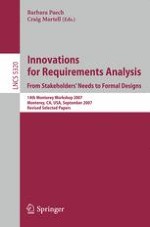Wearepleasedtopresenttheproceedingsofthe14thMontereyWorkshop,which tookplaceSeptember10–13,2007inMonterey,CA,USA. Inthispreface,wegive the reader an overview of what took place at the workshop and introduce the contributions in this Lecture Notes in Computer Science volume. A complete introduction to the theme of the workshop, as well as to the history of the Monterey Workshop series, can be found in Luqi and Kordon’s “Advances in Requirements Engineering: Bridging the Gap between Stakeholders’ Needs and Formal Designs” in this volume. This paper also contains the case study that many participants used as a problem to frame their analyses, and a summary of the workshop’s results. The workshop consisted of three keynote talks, three panels, presentations of peer-reviewed papers, as well as presentations of various position papers by the participants. The keynote speakers at this year’s workshop were Daniel Berry, Aravind Joshi, and Lori Clarke. Each of their talks was used to set the tone for the p- sentations and discussions for that particular day. Daniel Berry presented an overview of the needs and challenges of natural language processing in requi- ments engineering, with a special focus on ambiguity in his talk “Ambiguity in Natural Language Requirements. ” Aravind Joshi provided an overview of current natural language processing research in discourse analysis in the talk “Some Recent Developments in Natural Language Processing. ” Finally, Lori Clarke showed how to combine formal requirements speci?cation with natural language processing to cope with the complex domain of medical information processes in “Getting the Details Right.
